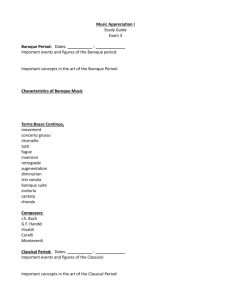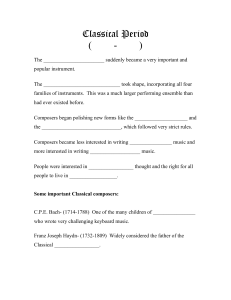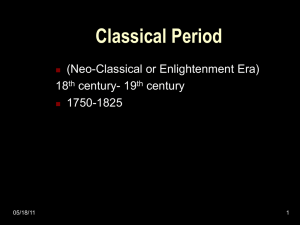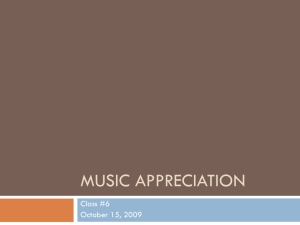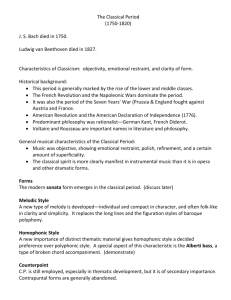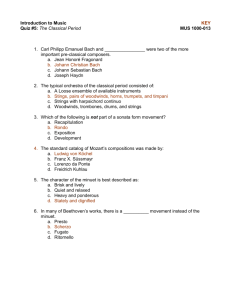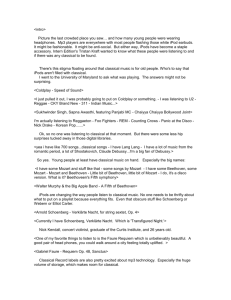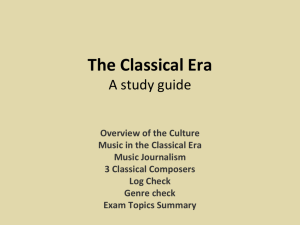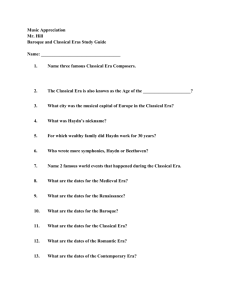THE CLASSICAL ERA (1770
advertisement
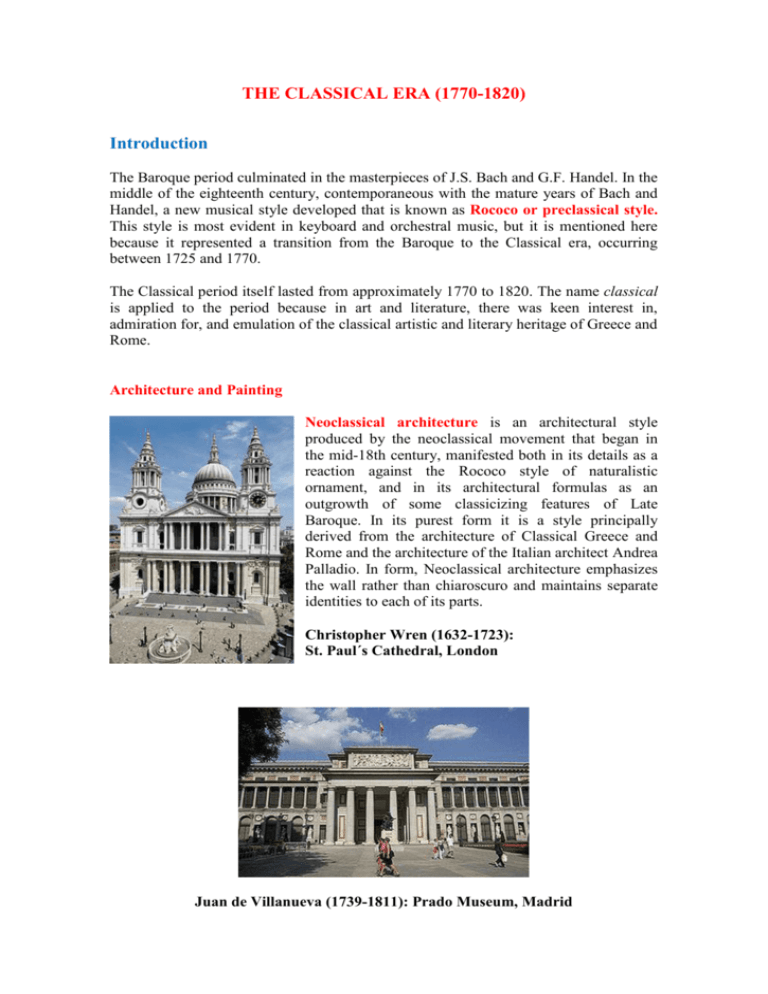
THE CLASSICAL ERA (1770-1820) Introduction The Baroque period culminated in the masterpieces of J.S. Bach and G.F. Handel. In the middle of the eighteenth century, contemporaneous with the mature years of Bach and Handel, a new musical style developed that is known as Rococo or preclassical style. This style is most evident in keyboard and orchestral music, but it is mentioned here because it represented a transition from the Baroque to the Classical era, occurring between 1725 and 1770. The Classical period itself lasted from approximately 1770 to 1820. The name classical is applied to the period because in art and literature, there was keen interest in, admiration for, and emulation of the classical artistic and literary heritage of Greece and Rome. Architecture and Painting Neoclassical architecture is an architectural style produced by the neoclassical movement that began in the mid-18th century, manifested both in its details as a reaction against the Rococo style of naturalistic ornament, and in its architectural formulas as an outgrowth of some classicizing features of Late Baroque. In its purest form it is a style principally derived from the architecture of Classical Greece and Rome and the architecture of the Italian architect Andrea Palladio. In form, Neoclassical architecture emphasizes the wall rather than chiaroscuro and maintains separate identities to each of its parts. Christopher Wren (1632-1723): St. Paul´s Cathedral, London Juan de Villanueva (1739-1811): Prado Museum, Madrid In the world of painting, Rococo style is characterized by delicate colours, many decorative details, and a graceful and intimate mood. Similarly, music in the Rococo style is homophonic and light in texture, melodic, and elaborately ornamented. In France, the term for this was style galant (gallant or elegant style) and in Germany empfindsamer stil (sensitive style). François Couperin (1668-1733), in France, and two of the sons of J. S. Bach, C. P. E. Bach (1714-1788) and Johann Christian Bach (17351782), in Germany, were important composers of music in the Rococo style. Antoine Watteau (1684-1721) : Embarcation for Kytera Jean Honoré Fragonard (1732-1806): The swing In the second half of the eighteenth century, a reaction against Rococo style occurred. There were objections to its lack of depth and to the use of decoration and ornamentation for their own sake. This led to the development of Classical style. The Age of Enlightenment Intellectually, this era has also been labeled the Age of Enlightenment. Philosophers such as Jean-Jacques Rousseau (1712-1778), Voltaire, and Montesquieu wrote of the value of the common person and the power of human reasoning in overcoming the problems of the world. This revolution in thinking inevitably led to conflict between the old order and new ideas. The French and American revolutions in the last quarter of the eighteenth century were stimulated by this new attitude. Music in the Classical era The musical scene in the classical period reflected the changes occurring in the society in which the music was being written. This was the first era in music history in which public concerts became an important part of the musical scene. Music was still being composed for the church and the court, but the advent of public concerts reflected the new view that music should be written for the enjoyment and entertainment of the common person. This period in music history is sometimes referred to as "the Viennese Classic period," and it was centered in Vienna. Beethoven, Haydn, and Mozart, though none was a native Viennese, all worked in Vienna for significant periods in their careers. Although Vienna was the focal point for musical activity of the period, classical music is universal in spirit and in style. Main composers: Haydn, Mozart, Beethoven Franz-Joseph Haydn (1732-1809) Franz Joseph Haydn was an Austrian composer, one of the most prolific and prominent composers of the Classical period. He is often called the "Father of the Symphony" and "Father of the String Quartet" because of his important contributions to these forms. He was also instrumental in the development of the piano trio and in the evolution of sonata form. A lifelong resident of Austria, Haydn spent much of his career as a court musician for the wealthy Esterházy family on their remote estate. Isolated from other composers and trends in music until the later part of his long life, he was, as he put it, "forced to become original". At the time of his death, he was one of the most celebrated composers in Europe. Wolfgang Amadeus Mozart (1756-1759) Wolfgang Amadeus Mozart was a prolific and influential composer of the Classical era. He composed over 600 works, many acknowledged as pinnacles of symphonic, concertante, chamber, operatic, and choral music. He is among the most enduringly popular of classical composers. Mozart showed prodigious ability from his earliest childhood in Salzburg. Already competent on keyboard and violin, he composed from the age of five and performed before European royalty. He learned voraciously from others, and developed a brilliance and maturity of style that encompassed the light and graceful along with the dark and passionate. His influence on subsequent Western art music is profound. Beethoven wrote his own early compositions in the shadow of Mozart, and Joseph Haydn wrote that “posterity will not see such a talent again in 100 years.” Ludwig van Beethoven (1770-1827) Ludwig van Beethoven was a German composer and pianist. A crucial figure in the transition between the Classical and Romantic eras in Western art music, he remains one of the most famous and influential of all composers. Born in Bonn, then the capital of the Electorate of Cologne and part of the Holy Roman Empire, Beethoven moved to Vienna in his early 20s, studying with Joseph Haydn and quickly gaining a reputation as a virtuoso pianist. His hearing began to deteriorate in his late twenties, yet he continued to compose, conduct, and perform, even after becoming completely deaf.
